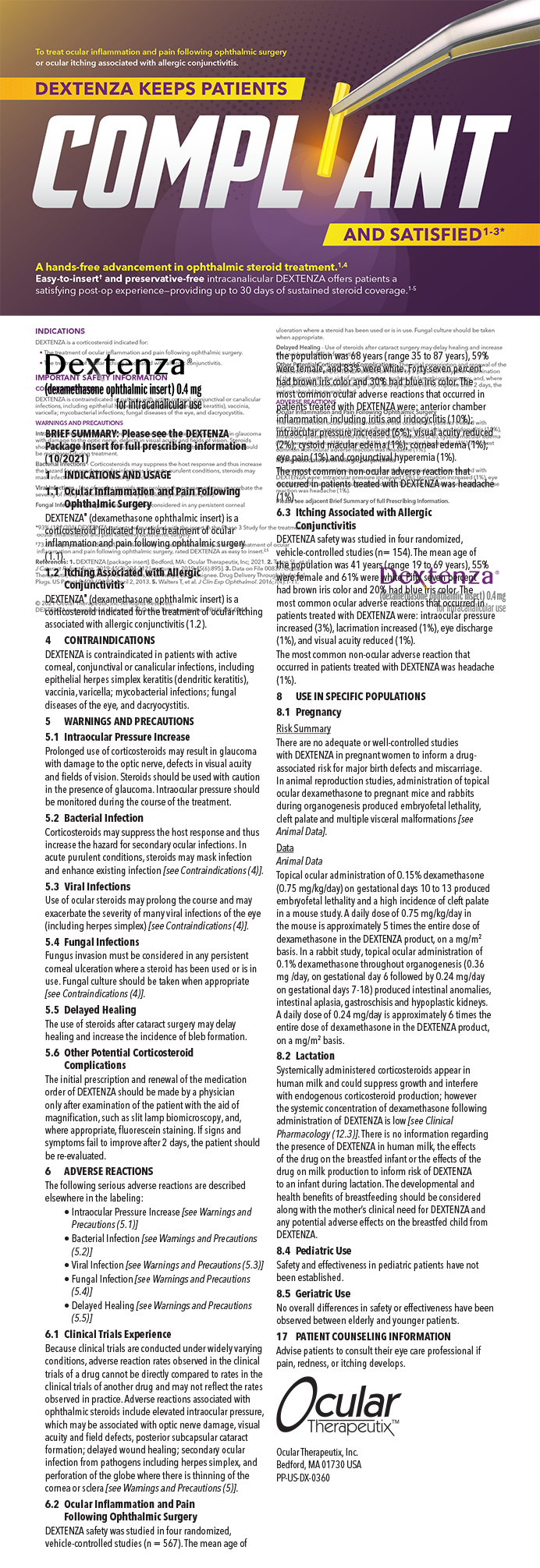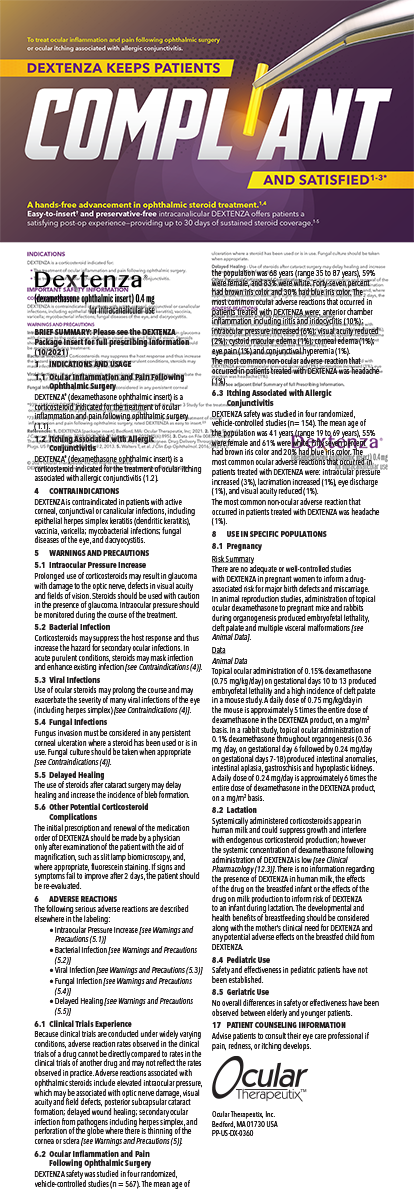

THE EFFECTS OF CATARACT SURGERY ON PATIENTS WITH WET MACULAR DEGENERATION
Saraf SS, Ryu CL, Ober MD, et al1
Abstract Summary
Saraf et al examined the effects of cataract surgery on the progression of wet age-related macular degeneration (AMD). In this retrospective review, researchers observed 82 eyes with wet AMD for 1 year. The surgery date was the midpoint of the study. Forty eyes underwent cataract surgery for visually significant cataracts, and the 42 eyes in the control group did not undergo surgery. The investigators compared BCVA, the number of antivascular endothelial growth factor (anti-VEGF) injections, and optical coherence tomography (OCT) features between the two groups. The number of anti-VEGF injections was recorded in the 6 months before and after the midpoint, whereas BCVA and OCT features were compared 3 months before and after the midpoint.
BCVA was equivalent in the first half of the study but then became significantly better in the surgical group versus the nonsurgical group (0.23 ±0.65 vs 0.11 ±0.59 logMAR improvement; P = .049). There was no change in the number of injections given 6 months before versus after the midpoint in the surgical group (P = .921). The mean central retinal thickness on OCT became greater in postsurgical eyes compared to nonsurgical eyes (265.4 ±98.4 μm vs 216.4 ±58.3 μm; P = .011). The eyes in the surgical group were more likely to develop new or worse cystoid changes after the study midpoint (13 surgical eyes [54.2%] vs 9 nonsurgical eyes [28.1%]; P = .048).
The authors concluded that cataract surgery improves vision and does not appear to contribute to the worsening of wet AMD. The anatomic changes based on OCT, however, suggested a subclinical susceptibility to postoperative cystoid macular edema or an exacerbation of choroidal neovascularization.
DISCUSSION
AMD and cataract are common causes of vision loss in the aging population. Anti-VEGF therapies have been reported to either stabilize or improve vision in a large proportion of cases,2-5 but many patients with wet AMD develop visually significant cataracts. There is a concern that cataract surgery on patients with wet AMD will exacerbate choroidal neovascularization or cause geographic atrophy to progress, and there is little in the literature to aid the decision-making process.6 This study by Saraf et al is the first to include a control arm and an examination of specific OCT features.
Previous research has provided mixed results as to whether or not cataract surgery worsens dry AMD, including studies that looked at the conversion of dry to wet AMD.7,8 Few studies have evaluated patients with wet AMD undergoing cataract surgery. Patients from the MARINA (Minimally Classic/Occult Trial of the Anti-VEGF Antibody Ranibizumab in the Treatment of Neovascular AMD) and ANCHOR (Anti-VEGF Antibody for the Treatment of Predominantly Classic Choroidal Neovascularization in AMD) trials demonstrated an improvement in BCVA.9 Tabandeh et al showed no difference in anti-VEGF requirements in a retrospective review of 30 patients in the time period before and after cataract surgery but a statistically significant improvement in BCVA.10 Grixti et al also found an improvement in BCVA after cataract surgery in patients with wet AMD as well as a transient increase in mean central retinal thickness on OCT that returned to baseline 3 months postoperatively.11
This study demonstrated that cataract surgery can improve BCVA in patients with active wet AMD without requiring an increase in anti-VEGF treatments. There were also no adverse outcomes such as macular hemorrhage or the development of subfoveal atrophy. The control group showed a decrease in the number of injections administered in the second half of the study compared to the first. The authors believe this trend represents the tendency of providers to use a treat-and-extend protocol, where the first three doses are given 1 month apart, then extended by 2 weeks until the signs of choroidal neovascularization recur, and are more likely to stick to a strict monthly dosing regimen in eyes during the perioperative period.
The OCT analysis showed that the mean central retinal thickness increased and that the presence of cysts worsened 3 months postoperatively, which also might have contributed to the anti-VEGF injection rates. Despite these OCT findings, eyes that underwent cataract surgery were found to have a sustained improvement in vision with ongoing anti-VEGF therapy.
The study by Saraf and colleagues suggests that cataract surgery can be safe in eyes undergoing anti-VEGF injections for wet AMD and that the procedure significantly improves visual acuity. These patients must be closely monitored, however, because there was a trend toward increased central macular thickness as well as the presence or worsening of intraretinal cysts 3 months postoperatively.
OPAQUE BUBBLE LAYER RISK FACTORS IN FEMTOSECOND LASER-ASSISTED LASIK
Courtin R, Saad A, Guilbert E, et al12
ABSTRACT SUMMARY
Courtin et al determined the characteristics and risk factors for the occurrence of an opaque bubble layer (OBL) during LASIK flap creation with a femtosecond laser. The study included 198 eyes of 102 consecutive patients who underwent LASIK flap creation with the WaveLight FS200 laser (Alcon). The investigators collected preoperative parameters, including manifest refraction, corneal keratometry, central corneal thickness (CCT), white-to-white corneal diameter, corneal hysteresis, corneal resistance factor, and programmed parameters for flap creation. They also analyzed digital images recorded after flap creation to measure OBL areas.
The incidence of an OBL was 48%. In the OBL group, the mean OBL area as a percentage of the corneal flap area was 4.25% ±7.16% (range, 0%-32.9%). The CCT (r = 0.242, P = .001), corneal resistance factor (r = 0.254, P = .028), and corneal hysteresis (r = 0.351, P < .0001) were significantly positively correlated with the OBL area. Corneal hysteresis and the OBL area were positively correlated independently of CCT and other confounding factors with a standardized coefficient (r = 0.353 ±0.227, P = .002). This large study confirms the already known OBL risk factors and suggests for the first time that elevated corneal hysteresis is an independent predictive risk factor for OBL occurrence.
DISCUSSION
An excessive OBL can interfere with the pupil tracker and intraoperative pachymetery and make lifting the flap difficult, resulting in an undercorrection.13 No serious complications, however, have occurred as a result of an OBL.13,14
This study confirmed the correlation between CCT and OBL but in a larger population than in previous studies.15,16 This research included 101 right eyes and 97 left eyes. Of the 102 patients, 62.7% (64 patients) were female. The mean age was 34.20 ±9.83 years (range, 20-69 years). The mean CCT in the group without an OBL versus the group with an OBL was 563.87 ±28.75 µm and 577.32 ±26.40 µm, respectively (P = .001).
This is the first study to find a positive correlation between corneal biomechanics and an OBL. The corneal resistance factor in the no OBL group and the OBL group was 11.07 ±1.64 and 11.50 ±1.52, respectively. The corneal hysteresis was 10.99 ±1.28 in the no OBL group and 11.85 ±1.37 in the OBL group. This study also found a linear correlation between corneal hysteresis and the occurrence of an OBL that was independent of CCT and other confounding factors. The authors pointed out that these correlations were weak and were the main limitation of the study.
The authors hypothesized that the lower corneal elasticity and higher viscosity that are associated with a higher corneal hysteresis might increase the occurrence of an OBL due to the lower capacity for reversible deformation of the cornea with a greater gas bubble infiltration between the stromal lamellae. The authors also noted that the femtosecond laser used in the study can create a ventilation canal to minimize the occurrence of an OBL, but this can also be associated with complications.17
The investigators concluded that OBL formation was frequent but was of no consequence in these eyes. They also identified increased corneal hysteresis and corneal resistance factor as risk factors for OBL formation. Future studies could compare refractive and visual outcomes in eyes with and without an OBL.
1. Saraf SS, Ryu CL, Ober MD, et al. The effects of cataract surgery on patients with wet macular degeneration. Am J Ophthalmol. 2015;160(3):487-492.
2. Fung AE, Lalwani GA, Rosenfeld PJ, et al. An optical coherence tomography-guided, variable dosing regimen with intravitreal ranibizumab (Lucentis) for neovascular age-related macular degeneration. Am J Ophthalmol. 2007;143(4): 566-583.
3. Kaiser PK, Brown DM, Zhang K, et al. Ranibizumab for predominantly classic neovascular age-related macular degeneration: subgroup analysis of first-year ANCHOR results. Am J Ophthalmol. 2007;144(6):850-857.
4. Rosenfeld PJ, Brown DM, Heier JS, et al. Ranibizumab for neovascular age-related macular degeneration. N Engl J Med. 2006;355(14):1419-1431.
5. Regillo CD, Brown DM, Abraham P, et al. Randomized, double-masked, sham-controlled trial of ranibizumab for neovascular age-related macular degeneration: PIER Study year 1. Am J Ophthalmol. 2008;145(2):239-248.
6. Wang JJ, Klein R, Smith W, Klein BEK, et al. Cataract surgery and the 5-year incidence of late-stage age-related maculopathy: pooled findings from the Beaver Dam and Blue Mountains eye studies. Ophthalmology. 2003;110:1960-1967.
7. Baatz H, Darawsha R, Ackermann H, et al. Phacoemulsification does not induce neovascular age-related macular degeneration. Invest Ophthalmol Vis Sci. 2008;49(3):1079-1083.
8. Sutter FKP, Menghini M, Barthelmes D, et al. Is pseudophakia a risk factor for neovascular age-related macular degeneration? Invest Ophthalmol Vis Sci. 2007;48(4):1472-1475.
9. Rosenfeld PJ, Shapiro H, Ehrlich JS, et al, MARINA and ANCHOR Study Groups. Cataract surgery in ranibizumab-treated patients with neovascular age-related macular degeneration from the phase 3 ANCHOR and MARINA trials. Am J Ophthalmol. 2011;152(5):793-798.
10. Tabandeh H, Chaudhry NA, Boyer DS, et al. Outcomes of cataract surgery in patients with neovascular age-related macular degeneration in the era of anti-vascular endothelial growth factor therapy. J Cataract Refract Surg. 2012;38(4):677-682.
11. Grixti A, Papavasileiou E, Cortis D, et al. Phacoemulsification surgery in eyes with neovascular age-related macular degeneration. ISRN Ophthalmol. 2014;2014: 417603.
12. Courtin R, Saad A, Guilbert E, et al. Opaque bubble layer risk factors in femtosecond laser-assisted LASIK. J Refract Surg. 2015;31(9):608-612.
13. Kaiserman I, Maresky HS, Bahar I, Rootman DS. Incidence, possible risk factors, and potential effects of an opaque bubble layer created by a femtosecond laser. J Cataract Refract Surg. 2008;34:417-423.
14. Kanellopoulos AJ, Asimellis G. Essential opaque bubble layer elimination with novel LASIK flap settings in the FS200 femtosecond laser. Clin Ophthalmol. 2013;7:765-770.
15. Soong HK, Malta JB. Femtosecond lasers in ophthalmology. Am J Ophthalmol. 2009;147:189-197.
16. Liu CH, Sun CC, Hui-Kang Ma D, et al. Opaque bubble layer: incidence, risk factors, and clinical relevance. J Cataract Refract Surg. 2014;40:435-440.
17. Au J, Krueger RR. Interface blood as a new indication for flap lift after LASIK using the WaveLight FS200 femtosecond laser. J Refract Surg. 2014;30:858-860.
Section Editor Edward Manche, MD
• director of cornea and refractive surgery at the Stanford Eye Laser Center
• professor of ophthalmology at the Stanford University School of Medicine, Stanford, California
• edward.manche@stanford.edu
Michael Greenwood, MD
• fellow, glaucoma, cornea, cataract, and refractive surgery, Vance Thompson Vision, Sioux Falls, South Dakota
• (605) 361-3937; migreenw@gmail.com; Twitter: @migreenw
• financial interest: none acknowledged
Vance Thompson, MD
• cataract and refractive surgery, Vance Thompson Vision, Sioux Falls, South Dakota
• (605) 361-3937; vancethompson@vancethompsonvision.com
• financial disclosure: consultant to Alcon


